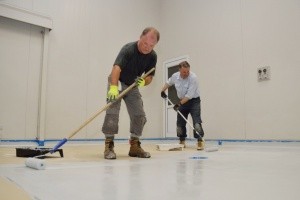“Epoxy Flooring” has become a very misunderstood word in the industrial manufacturing world. Too often, we hear potential customers talking about needing an “epoxy floor coating”. In reality, and utilizing the correct nomenclature, these people likely require some kind of polymer, or resinous, floor coating system.
Resinous floor coatings encompass a number of different polymer technologies, including but not limited to epoxies, urethanes, polyaspartics, methyl methacrylates (MMA), and vinyl esters. Each technology is suited for different applications, and each technology might have different variations to achieve certain performance characteristics. These include wear and abrasion resistance, chemical resistance, and aesthetics, to name a few. Furthermore, a finished floor coating system might utilize one of more of these technologies in conjunction with each other. The most common example would be a standard “workhorse” coating system comprised of an epoxy primer and build coat that is top coated with a chemical-resistant urethane product.
In this article, we are going to focus on one resinous flooring technology, epoxy coatings. Specifically, we will take a look at Protective Industrial Polymers’ Protect 1000 Universal Epoxy Coating System. This system is a workhorse epoxy system that utilizes a base resin, with alternate curing agents that target specific performance requirements.
Product Description:
Protect 1000 is a two-component (three-component when pigmented), universal, 100% solids, epoxy resin coating system that can be applied as a clear or pigmented coating or primer. Protect 1000 is supplied with a choice of curing agents to achieve specific cure rates, chemical resistance requirements and final aesthetics. This product produces a gloss finish.
Product Uses:
Used as a primer, build coat, broadcast, grout filler and top coat simply by selecting and mixing with the correct curing agent.
Product Advantages:
- Match the curing agent to the needs of the project.
- Extremely low odor
- High build application
- Excellent impact and abrasion resistance
- Seals substrate, reducing water vapor intrusion
- Resists staining from cleaning and industrial chemicals
- Complies with VOC regulations for industrial maintenance coatings in the OTC and CA*.
Curing Agent Options:
Protect 1000-A resin can be supplied with any of the following curing agents to achieve a specific result, or address a unique performance requirement.
Protect 1000CR-B: This curing agent offers the best chemical resistance and is recommended for use as a direct to concrete primer. This coating is not intended for final finish applications which require stringent UV stability as it will amber the most in comparison to the other curing agents.
Protect 1000HB-B: A general purpose curing agent with good UV and chemical resistance properties. Protect 1000HB exhibits excellent gloss and aesthetics with extremely low blush propensity. Protect 1000HB is not intended for direct-to-concrete applications where there are known or suspected high levels of water vapor transmission.
Protect 1000FS-B: This curing agentprovides up to a 50% faster curing time than 1000HB-B, 1000CR-B and Protect 1000ST-B. Protect 1000FS exhibits excellent gloss and aesthetics with low blush propensity. Protect 1000FS-B will amber (slightly more than 1000HB but much less than 1000CR) and is not recommended for final finish applications which require stringent UV stability. Protect 1000FS-B has a reduced working time and recoat window and must be sanded within 8 hours in temperatures above 75F and 12 hours in temperatures between 60 and 70F. Contact Protective Industrial Polymers with specific requirements, recommendations and limitations.
Protect 1000ST-B: A general purpose curing agent with increased rheology which provides for an orange peel or slightly stippled finish when applied at 5-6 mils. Protect 1000ST exhibits good UV and chemical resistance properties, excellent gloss and aesthetics with extremely low blush propensity. Protect 1000ST is not intended for direct-to-concrete applications where there are known or suspected high levels of water vapor transmission.
The above encompasses one specific epoxy coating product. Even with epoxies, there are different variations designed to address specific requirements. These include water-reducible epoxies, epoxy novalacs, solvent-borne epoxies, and flexible hybrid epoxies, to name a few. You can learn more about PIP’s epoxy coating products here.
Understanding how different curing agents work within an epoxy coating system can certainly be a benefit when researching polymer floor coating options, however it is just one part of the overall puzzle. Floor coating projects require extensive knowledge of concrete substrates, surface preparation procedures, installation techniques, and material intricacies. It is always recommended to consult with your preferred material vendor or installation contractor prior to attempting to tackle a floor coating project yourself.
Do you have a flooring project, but don’t know where to start? Our Industrial Flooring Self-Assessment Tool can help you determine the ideal solution for your unique application.

- Aesthetics: The Art and Science of Decorative Flooring - August 28, 2025
- Why Epoxy Mortar Outperforms Traditional Concrete in Industrial Applications - August 27, 2025
- How Antimicrobial Flooring Supports Health and Safety in Critical Environments - August 22, 2025



